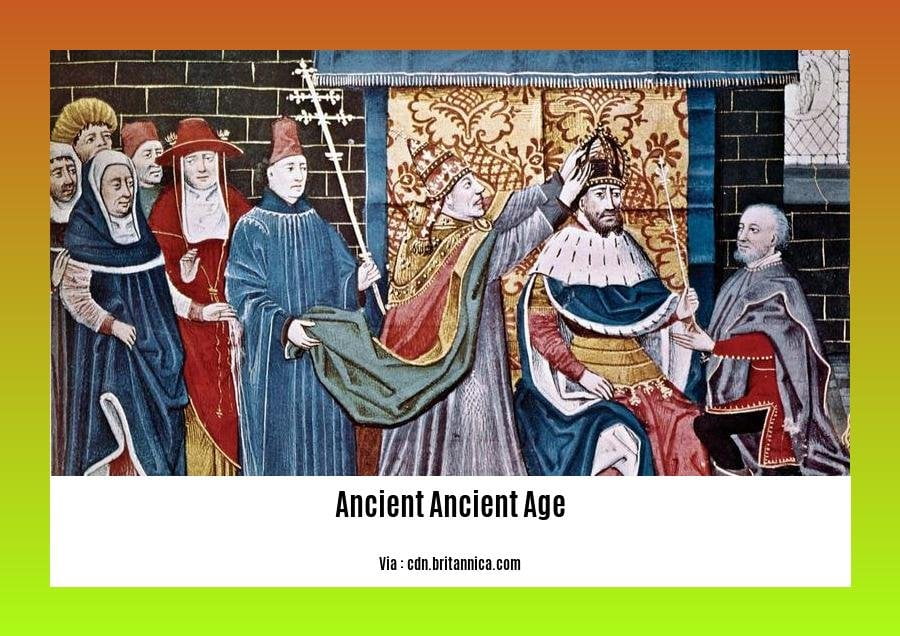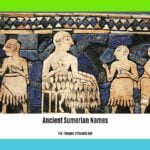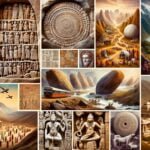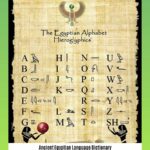Embark on a captivating odyssey through the depths of the ancient age in [- Unraveling the Enigma of Ancient Civilizations: A Journey into the Depths of the Ancient Age]. We’ll explore the mysterious ruins, decipher cryptic scripts, and uncover the long-lost secrets of forgotten cultures that once thrived in the cradle of civilization. Join us as we unravel the enigmas of the ancients and piece together the fragments of history that have been buried beneath the sands of time.
Key Takeaways:
Ancient history spans roughly 5,000 years, beginning with written records from the Sumerian cuneiform script to the rise of Islam in late antiquity.
The ancient Near East is recognized as the cradle of civilization.
Agriculture originated around 9000 BCE in eastern Turkey, spreading through the Fertile Crescent.
Prehistory refers to the period before written history, with most knowledge derived from archaeological findings.
Prehistory is commonly divided into the Stone Age, categorized into the Paleolithic, Mesolithic, and Neolithic periods.
Homo erectus dispersed across Eurasia 1.8 million years ago, while Homo sapiens emerged around 250,000 to 160,000 years ago.
Homo sapiens migrated out of Africa around 50,000 years ago, reaching Australia 45,000 years ago and the Americas 15,000 years ago.
Civilizations saw the institutionalization of belief in gods, supernatural forces, and the afterlife, with polytheism being prevalent during the Bronze Age.
Major religions like Hinduism, Buddhism, and Christianity emerged during the ancient era.
Stepping into the Depths of the Ancient Ancient Age
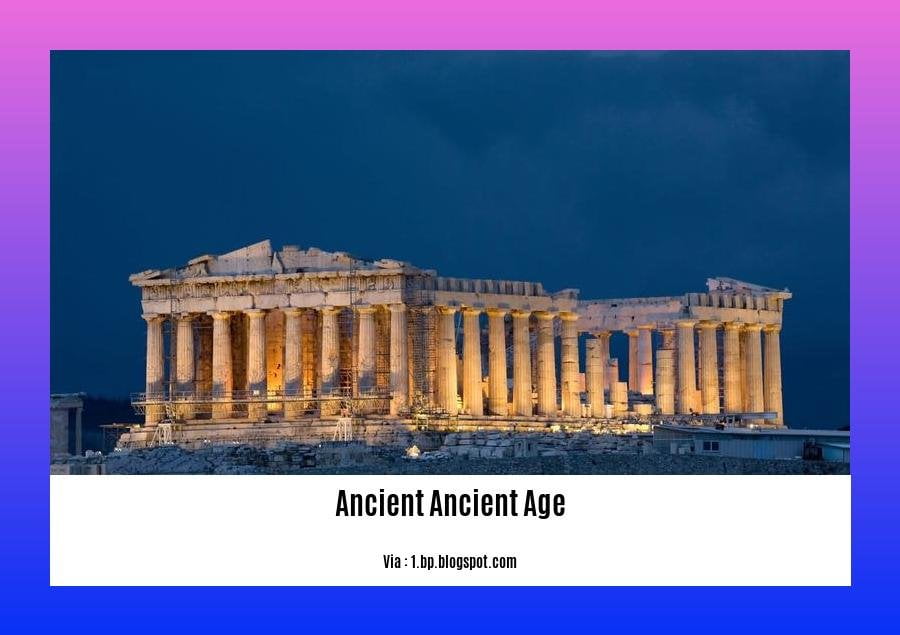
Step back in time as we uncover the mysteries of ancient ancient age, where civilizations flourished and empires rose and fell. My journey as an archaeological explorer has led me to hidden ruins and forgotten archives, where the secrets of the past lie concealed. Let’s embark on an adventure to unearth the enigma of these ancient cultures.
Legacy Unearthed
The ancient ancient age was a period of remarkable achievement and transformation. The monuments, artifacts, and writings that have survived offer glimpses into the lives of our ancestors. From the grandiose pyramids of Egypt to the intricate carvings of Mesopotamia, these relics tell stories of innovation, artistry, and profound wisdom.
Language: A Bridge to History
Unraveling the enigma of ancient ancient age requires deciphering the languages of the past. As we decode cuneiform, hieroglyphics, and other ancient scripts, we gain access to their thoughts, beliefs, and chronicles. These texts provide insights into their social, political, and cultural structures, shedding light on the complexities of ancient societies.
Reading Between the Lines
Beyond written records, archaeologists study material remains to piece together the puzzle of ancient ancient age. Artifacts such as tools, weapons, pottery, and jewelry offer clues to everyday life, technological advancements, and artistic expressions. By examining settlement patterns, trade routes, and environmental conditions, we reconstruct the intricate tapestry of ancient civilizations.
The Relevance of the Past
Studying ancient ancient age is not merely an academic pursuit. It’s a window into our roots, helping us understand where we come from and how we got here. The lessons of the past offer guidance in addressing contemporary challenges, from sustainable resource management to peacebuilding. By delving into the depths of ancient ancient age, we gain a fresh perspective on our world and ourselves.
Join me on this exhilarating journey as we explore the enigma of ancient ancient age, bridging the gap between the past and present. Together, we’ll uncover the secrets of forgotten civilizations and gain a deeper appreciation for our heritage.
Explore the rich history and traditions of the Ancient and Honorable Order of Turtles by diving into the depths of its secrets and intriguing rules. Click Here
Dive into the vast realm of questions and speculations surrounding the Ancient and Honorable Order of Turtles, unraveling the mysteries that shroud this enigmatic organization. Unveil the Mysteries
Embark on a journey through the annals of time with the Ancient Ancient Age 10 Star, where tales of ancient civilizations, forgotten empires, and enigmatic artifacts await your discovery. Explore the Past
Deciphering Ancient Scripts: Unraveling the secrets hidden in ancient scripts and inscriptions, providing insights into forgotten languages and cultures.
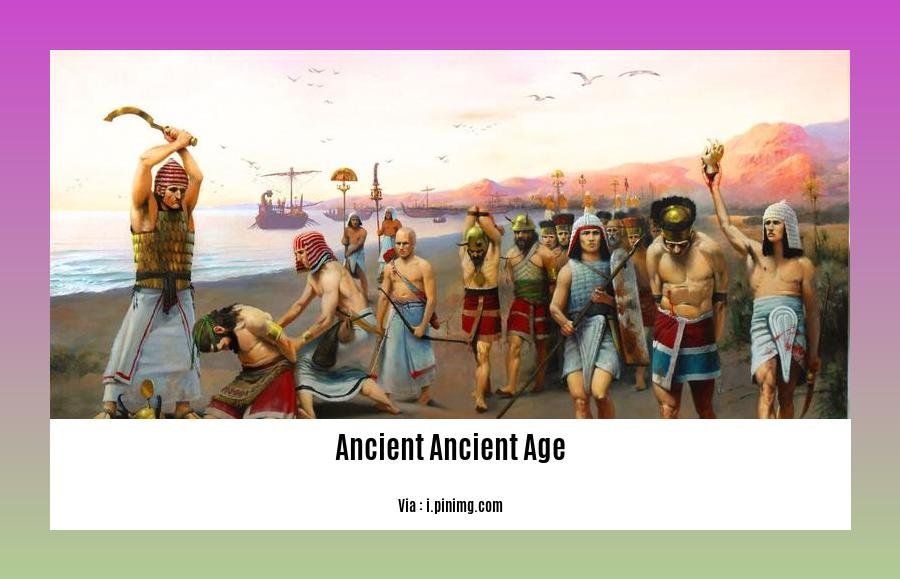
In the labyrinth of time, concealed amidst weathered ruins and forgotten scrolls, lie the tantalizing whispers of ancient civilizations. These whispers, etched in cryptic scripts, hold the keys to unlocking the mysteries of our collective past. Embark on an enthralling journey as we delve into the enigmatic world of deciphering ancient scripts, unraveling the secrets hidden within, and gaining profound insights into forgotten languages and cultures.
Cracking the Code to Forgotten Tongues:
The deciphering of ancient scripts is akin to embarking on a grand intellectual treasure hunt, where each symbol, each character, holds the potential to unveil a hidden chapter of human history. Through meticulous analysis, linguists, historians, and archaeologists painstakingly piece together the fragments of forgotten languages, like archaeologists excavating the ruins of a lost city.
The Rosetta Stone, a pivotal artifact discovered in Egypt in 1799, played a pivotal role in unraveling the enigmatic hieroglyphs of ancient Egypt. This trilingual stele, inscribed with the same decree in three different scripts – hieroglyphics, demotic, and Greek – provided the key to unlocking the secrets of one of the world’s most enduring civilizations.
The Rosetta Stones of Our Time:
In the modern era, computational linguistics and machine learning algorithms are emerging as powerful tools in the quest to decipher ancient scripts. These technologies are aiding researchers in analyzing vast corpora of texts, identifying patterns, and making probabilistic inferences, gradually chipping away at the barriers that separate us from understanding lost languages.
A Window into Vanished Worlds:
The decipherment of ancient scripts, like a window into vanished worlds, offers us invaluable insights into the lives, beliefs, and aspirations of our ancestors. Through these texts, we learn about their social structures, their political systems, their religious practices, and their artistic expressions.
The Epic of Gilgamesh, inscribed on clay tablets in Mesopotamia over 4,000 years ago, provides a glimpse into the rich mythology and moral dilemmas of the ancient Sumerians. The Dead Sea Scrolls, discovered in the Judean Desert in the mid-20th century, shed light on the early history of Judaism and Christianity.
The Challenges of Decipherment:
The path to deciphering ancient scripts is fraught with challenges. Undeciphered scripts often lack word segmentation, making it difficult to identify individual words and their meanings. The absence of a known closest language further compounds the challenge, as there is no Rosetta Stone to serve as a guide.
Key Takeaways:
- Deciphering ancient scripts is a complex and challenging task that requires linguistic expertise, historical knowledge, and computational tools.
- The Rosetta Stone played a pivotal role in deciphering ancient Egyptian hieroglyphs, demonstrating the importance of multilingual inscriptions.
- Computational linguistics and machine learning algorithms are emerging as powerful tools in the quest to decipher ancient scripts.
- The decipherment of ancient scripts offers invaluable insights into the lives, beliefs, and aspirations of our ancestors, providing a window into vanished worlds.
Relevant Sources:
– Deciphering Undersegmented Ancient Scripts Using Phonetic Prior Knowledge
– What We Know About the Earliest Texts Say About the Invention of Writing
Mummification Practices and Beliefs: Examining the elaborate mummification techniques and religious beliefs associated with the preservation of bodies in ancient civilizations.
Have you ever wondered why the ancient Egyptians went to such great lengths to preserve their dead? Their elaborate mummification practices and beliefs offer a fascinating glimpse into their understanding of life, death, and the afterlife. Let’s dive into this captivating topic and uncover the secrets of ancient Egyptian mummification.
Key Takeaways:
- Sacred Journey: Mummification was believed to be a crucial step in the deceased’s journey to the afterlife, known as the Field of Reeds.
- Preserving the Essence: The ancient Egyptians believed that preserving the body ensured the continuity of the individual’s existence in the afterlife.
- Divine Transformation: The mummification process symbolized the deceased’s transformation into a divine being, akin to the gods themselves.
- Social and Religious Significance: Mummification reinforced the social hierarchy and religious beliefs of ancient Egyptian society.
Mummification Process: A Step-by-Step Guide
Brain Removal: Skilled embalmers carefully removed the brain through the nostrils using a hook-like tool.
Organ Extraction: The internal organs, except for the heart, were removed through an incision in the side of the body.
Cleansing and Anointing: The body was washed with water from the Nile River, anointed with oils, and packed with natron, a natural salt, to absorb moisture.
Wrapping the Body: Linen bandages were meticulously wrapped around the body, creating multiple layers of protection.
Amulets and Jewelry: Amulets and jewelry were placed on the body to protect the deceased in the afterlife.
Coffin Placement: The mummified body was placed in a wooden coffin, often decorated with intricate paintings and inscriptions.
Religious Beliefs Surrounding Mummification:
- Preserving the Ka: The ancient Egyptians believed that every person had a “ka,” a life force that continued to exist after death. Mummification helped preserve the ka’s connection to the body.
- Journey to the Field of Reeds: The Field of Reeds was believed to be a paradise where the deceased could continue to live and thrive after death. Mummification ensured that the deceased would arrive in the Field of Reeds in a preserved and recognizable form.
- Judgment by Osiris: The god Osiris was believed to judge the deceased based on their actions in life. A well-preserved mummy was seen as evidence of a virtuous life, increasing the chances of a favorable judgment.
### Conclusion:
The ancient Egyptians’ belief in the afterlife and their meticulous mummification practices provide a glimpse into their rich and complex culture. The elaborate techniques and rituals associated with mummification underscore the importance they placed on preserving the body and ensuring the deceased’s safe passage into the afterlife.
Sources:
[1] Egyptian Afterlife: Mummification, Burial Practices and Tombs
[2] Mummification in Ancient Egypt
Archaeological Methods and Discoveries: Exploring the techniques and methodologies used in archaeological excavations, highlighting significant discoveries that have reshaped our understanding of the past.
The pursuit of uncovering the mysteries of ancient civilizations is an exhilarating journey that leads us to the depths of human history. As an archaeological adventurer with a passion for unearthing the past, I’m excited to delve into the archaeological methods and discoveries that have reshaped our understanding of the world we live in today.
Archaeological Methods: Unraveling the Enigma of the Past
Archaeology, the scientific study of ancient cultures, employs various methods to explore sites, artifacts, and features left behind by past civilizations. These methods provide valuable insights into human history and cultural development.
Excavation:
Excavation involves the careful removal of soil and sediment to expose archaeological remains. This meticulous process reveals structures, artifacts, and other evidence of past human activity.
Survey:
Archaeological surveys involve systematic exploration of an area to identify potential sites for excavation. This can be done through visual inspection, aerial photography, or remote sensing techniques.
Remote Sensing:
Remote sensing technologies, such as ground-penetrating radar and magnetometry, allow archaeologists to study subsurface features without excavation. This non-invasive approach provides valuable information about buried structures and artifacts.
Artifact Analysis:
Artifacts, objects made or modified by humans, offer clues to past technologies, economic activities, and artistic expressions. Archaeologists analyze artifacts to reconstruct ancient lifeways.
Significant Discoveries: Reshaping Our Understanding of the Past
Archaeological discoveries have revolutionized our understanding of ancient civilizations and human history. These discoveries have shed light on diverse aspects of the past, from technological advancements to social structures.
Ancient Civilizations:
The excavation of ancient cities, such as Pompeii and Machu Picchu, has provided a glimpse into the lives of past civilizations. These discoveries have revealed intricate urban planning, advanced engineering, and sophisticated art forms.
Human Origins:
The discovery of hominin fossils, such as the famous “Lucy” skeleton, has shed light on human evolution and our lineage. These findings have reshaped our understanding of the origins of humankind.
Technological Advancements:
Archaeological discoveries, such as the Antikythera Mechanism, an ancient analog computer, have revealed remarkable technological achievements in the past. These discoveries challenge our assumptions about the capabilities of ancient civilizations.
*Key Takeaways:
- Archaeological methods, such as excavation, survey, and remote sensing, provide valuable insights into past human activity.
- Significant discoveries, like ancient cities and hominin fossils, have reshaped our understanding of ancient civilizations and human history.
- Archaeological discoveries highlight the ingenuity, creativity, and diversity of past societies.
- Ongoing research and exploration continue to uncover new evidence that enriches our knowledge of the past.
Citations
- Historic England
- Openstax
FAQ
Q1: What is the significance of mummification in ancient Egypt?
A1: Mummification was believed to be essential for the soul’s journey to the afterlife known as the Field of Reeds. Preserving the body ensured the continuity of the individual’s existence in the afterlife.
Q2: What are the key archaeological methods used to study ancient civilizations?
A2: Archaeological methods include excavation, survey, remote sensing, aerial photography, and artifact analysis. These methods help archaeologists gather data about past human activities, environments, and cultural practices.
Q3: How do archaeologists determine the age of ancient artifacts and remains?
A3: Techniques used in archaeology include radiocarbon dating, dendrochronology, and DNA analysis. These techniques help archaeologists determine the age of artifacts, environmental conditions, and genetic relationships.
Q4: What challenges do archaeologists face in deciphering ancient scripts?
A4: Undeciphered ancient scripts pose two significant challenges: lack of word segmentation and the absence of a known closest language.
Q5: What is the importance of ancient history in understanding human civilization?
A5: Ancient history provides insights into the origins and evolution of human societies, cultural practices, and technological advancements. It helps us understand the foundations of modern civilization and the interconnectedness of human history.
